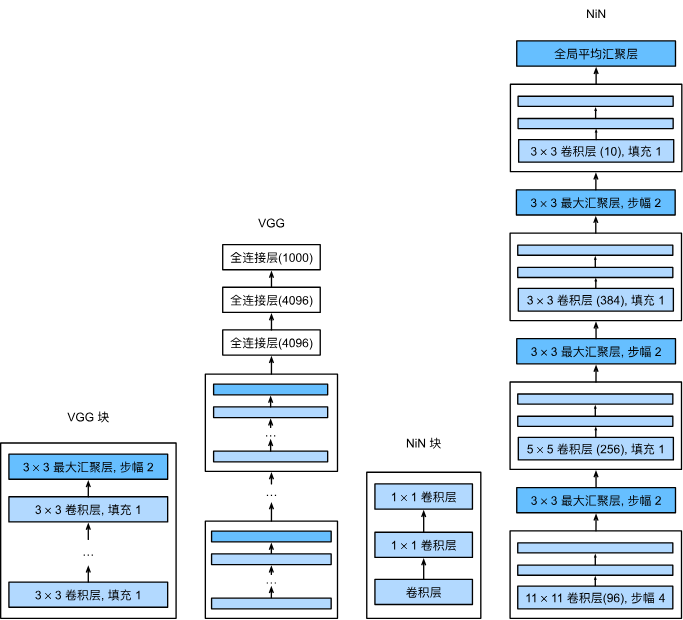网络中的网络(NiN)
LeNet、AlexNet和VGG都有一个共同的设计模式:通过一系列的卷积层与汇聚层来提取空间结构特征;然后通过全连接层对特征的表征进行处理。 AlexNet和VGG对LeNet的改进主要在于如何扩大和加深这两个模块。 或者,可以想象在这个过程的早期使用全连接层。然而,如果使用了全连接层,可能会完全放弃表征的空间结构。 网络中的网络(NiN)提供了一个非常简单的解决方案:在每个像素的通道上分别使用多层感知机。
NiN块
回想一下,卷积层的输入和输出由四维张量组成,张量的每个轴分别对应样本、通道、高度和宽度。 另外,全连接层的输入和输出通常是分别对应于样本和特征的二维张量。 NiN的想法是在每个像素位置(针对每个高度和宽度)应用一个全连接层。 如果我们将权重连接到每个空间位置,我们可以将其视为\(1\times1\)卷积层(如我们在多输入输出通道中所述),或作为在每个像素位置上独立作用的全连接层。 从另一个角度看,即将空间维度中的每个像素视为单个样本,将通道维度视为不同特征(feature)。
下图说明了VGG和NiN及它们的块之间主要架构差异。 NiN块以一个普通卷积层开始,后面是两个\(1\times1\)的卷积层。这两个\(1\times1\)卷积层充当带有ReLU激活函数的逐像素全连接层。 第一层的卷积窗口形状通常由用户设置。 随后的卷积窗口形状固定为\(1\times1\)。

import torch
from torch import nn
from d2l import torch as d2l
# Define a function to create a NiN (Network in Network) block
def nin_block(in_channels, out_channels, kernel_size, strides, padding):
# Use nn.Sequential to chain multiple layers together
return nn.Sequential(
nn.Conv2d(in_channels, out_channels, kernel_size, strides, padding), # 1st convolutional layer
nn.ReLU(), # ReLU activation function
nn.Conv2d(out_channels, out_channels, kernel_size=1), # 2nd convolutional layer with 1x1 kernel
nn.ReLU(), # ReLU activation function
nn.Conv2d(out_channels, out_channels, kernel_size=1), # 3rd convolutional layer with 1x1 kernel
nn.ReLU() # ReLU activation function
)
NiN模型
最初的NiN网络是在AlexNet后不久提出的,显然从中得到了一些启示。 NiN使用窗口形状为\(11\times11\)、\(5\times5\)和\(3\times3\)的卷积层,输出通道数量与AlexNet中的相同。 每个NiN块后有一个最大汇聚层,汇聚窗口形状为\(3\times3\),步幅为2。
NiN和AlexNet之间的一个显著区别是NiN完全取消了全连接层。 相反,NiN使用一个NiN块,其输出通道数等于标签类别的数量。最后放一个全局平均汇聚层(global average pooling layer),生成一个对数几率 (logits)。NiN设计的一个优点是,它显著减少了模型所需参数的数量。然而,在实践中,这种设计有时会增加训练模型的时间。
# Define the neural network architecture using nn.Sequential
net = nn.Sequential(
# Add a nin_block with input channels 1, output channels 96, kernel size 11, stride 4, and padding 0
nin_block(1, 96, kernel_size=11, strides=4, padding=0),
# Add a 2D max pooling layer with kernel size 3 and stride 2
nn.MaxPool2d(3, stride=2),
# Add a nin_block with input channels 96, output channels 256, kernel size 5, stride 1, and padding 2
nin_block(96, 256, kernel_size=5, strides=1, padding=2),
# Add a 2D max pooling layer with kernel size 3 and stride 2
nn.MaxPool2d(3, stride=2),
# Add a nin_block with input channels 256, output channels 384, kernel size 3, stride 1, and padding 1
nin_block(256, 384, kernel_size=3, strides=1, padding=1),
# Add a 2D max pooling layer with kernel size 3 and stride 2
nn.MaxPool2d(3, stride=2),
# Add a dropout layer with a dropout probability of 0.5
nn.Dropout(0.5),
# Add a nin_block with input channels 384, output channels 10, kernel size 3, stride 1, and padding 1
nin_block(384, 10, kernel_size=3, strides=1, padding=1),
# Add an adaptive average pooling layer with output size (1, 1)
nn.AdaptiveAvgPool2d((1, 1)),
# Add a flatten layer to flatten the input
nn.Flatten()
)
我们创建一个数据样本来查看每个块的输出形状。
X = torch.rand(size=(1, 1, 224, 224))
for layer in net:
X = layer(X)
print(layer.__class__.__name__, 'output shape:\t', X.shape)
Sequential output shape: torch.Size([1, 96, 54, 54])
MaxPool2d output shape: torch.Size([1, 96, 26, 26])
Sequential output shape: torch.Size([1, 256, 26, 26])
MaxPool2d output shape: torch.Size([1, 256, 12, 12])
Sequential output shape: torch.Size([1, 384, 12, 12])
MaxPool2d output shape: torch.Size([1, 384, 5, 5])
Dropout output shape: torch.Size([1, 384, 5, 5])
Sequential output shape: torch.Size([1, 10, 5, 5])
AdaptiveAvgPool2d output shape: torch.Size([1, 10, 1, 1])
Flatten output shape: torch.Size([1, 10])
训练模型
和以前一样,我们使用Fashion-MNIST来训练模型。训练NiN与训练AlexNet和VGG相似。
lr, num_epochs, batch_size = 0.1, 10, 128
train_iter, test_iter = d2l.load_data_fashion_mnist(batch_size, resize=224)
d2l.train_ch6(net, train_iter, test_iter, num_epochs, lr, d2l.try_gpu())
loss 0.348, train acc 0.872, test acc 0.874
1038.0 examples/sec on cuda:0




【推荐】国内首个AI IDE,深度理解中文开发场景,立即下载体验Trae
【推荐】编程新体验,更懂你的AI,立即体验豆包MarsCode编程助手
【推荐】抖音旗下AI助手豆包,你的智能百科全书,全免费不限次数
【推荐】轻量又高性能的 SSH 工具 IShell:AI 加持,快人一步
· .NET Core 中如何实现缓存的预热?
· 从 HTTP 原因短语缺失研究 HTTP/2 和 HTTP/3 的设计差异
· AI与.NET技术实操系列:向量存储与相似性搜索在 .NET 中的实现
· 基于Microsoft.Extensions.AI核心库实现RAG应用
· Linux系列:如何用heaptrack跟踪.NET程序的非托管内存泄露
· TypeScript + Deepseek 打造卜卦网站:技术与玄学的结合
· 阿里巴巴 QwQ-32B真的超越了 DeepSeek R-1吗?
· 【译】Visual Studio 中新的强大生产力特性
· 【设计模式】告别冗长if-else语句:使用策略模式优化代码结构
· 10年+ .NET Coder 心语 ── 封装的思维:从隐藏、稳定开始理解其本质意义